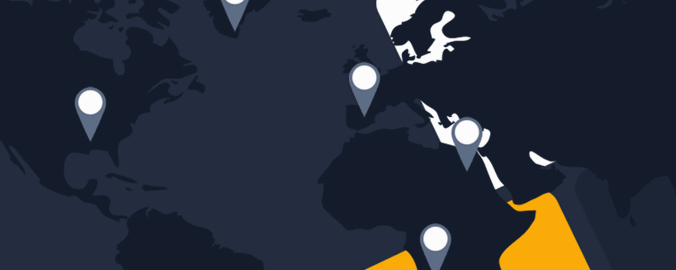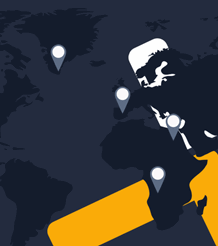
Italian Region Guide
Known affectionately by the Italians as lo stivale (the boot), Italy is chiefly made up of a large peninsula, with a distinctive shape that extends into the Mediterranean Sea. There, together with its two main islands of Sicily and Sardinia, it creates distinct bodies of water, the Adriatic Sea to the north east and the Ionean Sea to the south-east. Its south western shores are lapped by the Tyrrhenian Sea and the north western shores by the Ligurian Sea.
Lining the center of Italy, the Appenine Mountains form the backbone of the country, leading north until they blend into the Alps. At this point the large alluvial plain of the Po River can be found. Italy is also home to two volcanoes – the dormant Mount Vesuvius near Naples and the more active Etna on Sicily.
Although the Italian language is spoken throughout the country, Italy offers a wide cultural, economic, and political diversity. The country has the fifth highest population density in Europe. However the majority of the population is concentrated around the main cities such as Turin, Rome, Milan, and Naples.
Sport is highly popular in Italy and Italians are great fans and participants. Football is the most popular of all with basketball and cycling following close behind. Of course, Italy is home to Ferrari and motor sport has an important place in all Italian hearts.
Music is synonymous with Italy and it is known as the birthplace of opera. The piano and violin were invented here and Italians love music, from folklore to classical. Wherever you go, you will commonly hear music in the streets.
Climate & Natural Factors
Owing to its geography, the climate in Italy varies greatly from north to south. The north of Italy (Turin, Milan and Bologna) has a continental climate – hot summers and freezing cold winters. From Florence to the south, the climate becomes more Mediterranean.
- Sometimes referred to as the connoisseur’s alternative to Spain or France, Italy boasts an abundance of culture, history and magnificent architecture. It has a strong cultural tourism market and tourists flock to the cities of Rome, Florence and Venice seeking a rich Italian cultural experience.
- Italy offers a stunning variation in natural beauty. Tuscany and the lakes in the north are a firm favourite among investors with the funds to afford the high prices. Ski resorts such as Cortina offer similar top end investment opportunities. These contrast with rugged or sandy beaches on coastal areas including Sicily which are proving to be good opportunities for smaller bank balances.
- The warm Mediterranean climate attracts sun seeking tourists year-round. During summer all parts of Italy can experience very high temperatures, while the sirocco wind blows in from North Africa, acquiring humidity over the Mediterranean Sea. Meanwhile in the Italian Alps, winter weather allows for snow in the ski resorts.
- Italy offers a well developed tourist industry and recreational activities are available to cater for all needs, from skiing, hiking or beach holidays to sightseeing and cultural activities.
- For many, Italy offers the dream lifestyle. It is a modern EU country with efficient systems and friendly people, making Italy an easy relocation destination.
History of Italy
Archaeological excavations in Italy show there were settlements ranging back to the Palaeolithic era some 200,000 years ago. From that time on Italy has influenced the development of the western world both culturally and socially.
The Roman Empire dominated Europe for hundreds of years and left a set of laws, many of which still form the basis of the legal systems of numerous modern countries. Through the Holy Roman Empire, Italy was the centre of Christianity and the cradle of the Renaissance. It was the hub of art and science investigation that would influence the rest of the world.
The world would be poorer without the cultural legacy of Italy; from the earliest of Roman times to today it has left its mark on the world. Scientists such as Galileo Galilei, who invented the telescope, put us on the path of scientific discovery.
Napoleon had an influence on Italy when he invaded Italy. Although it was not a battlefield, many of the former states were reshaped during this time.
In March 1861 Italy became a united country after Guiseppe Garibaldi defeated the Austrians and organised invasion of the Kingdom of the Two Sicilies (Naples and Sicily). Victorio Emmanuel became the first king of the newly united country.
Later Mussolini formed a fascist dictatorship that lasted from 1922 to 1943. It was out of the ashes of this dictatorship that modern day Italy was born.
It is worth taking insect repellent as even inland towns, most notoriously Milan, suffer from a persistent mosquito problem, especially in summer.
The water is perfectly safe to drink and you'll find public fountains in squares and city streets everywhere, though look out for “acqua non potabile” signs, indicating that the water is unsafe to drink.
Information Required when Travelling to Italy
Visas
Not required for visitors from the EU. Australia, New Zealand, Canada and USA passport holders are limited to stays of three months
Vaccinations
No vaccinations are required
Time Zone
The time is Central European Standard time – GMT+1 summer, GMT +2 winter
Electricity
Current is 220 volts 50mhz European standard two pin plugs are used on appliances.
Currency
The Euro is the currency
Weights and Measures
The metric system is used
Tel. Dialing Code
00+39 (country code)+ area code + number
Italian Cuisine
Because Italy was historically composed of different states, you will find a great difference in cuisine as you travel through the country. What doesn’t vary however, is the approach to a meal, which can seem like a banquet and goes on for hours.
The main meal of the day will start with an antipasto, followed by a risotto or a pasta dish. This leads on to a fish or meat course, after that cheese, and last of all fresh fruit and coffee.
Eating in Trattorios is cheaper than in Ristorantes although both will offer you a wide choice of local cuisine. Eating in Italy is a gastronomic adventure and the dishes mentioned below are only a tiny sample of what is available.
In Rome try the abbacchio - suckling lamb in white wine flavoured with rosemary, or broccoli romani - broccoli in white wine. Then, of course, there is salsa romana - a sweet-sour brown sauce with raisins, chestnut and lentil purée served with game. Instead of pasta you could have gnocchi alla romana - semolina dumplings, which are delicious and light.
In northern regions of Italy where the winters are colder, you will find more “filling” foods such as minestrone - thick soup with chopped vegetables and osso buco - shin of veal cooked in tomato sauce served with rice.
When in Venice don’t miss the fegato alla veneziana - calves’ liver thinly sliced and cooked in butter with onions, or the baccalà alla vicentina - salted cod simmered in milk and eaten with wines such as Soave, Bardolino or Valpolicella.
In the southern regions you will find coniglio ai capperi - rabbit cooked with capers and ostriche - fresh oysters baked with breadcrumbs, all mouth-wateringly fresh. You will also find lasagne with artichokes and meatballs, onion soup prepared with Italian brandy, fresh sardines in olive oil and oregano and aubergines prepared in many different ways.
The islands of Sardinia and Sicily offer a wide choice of seafood. In Sardinia lobster is served in stews, grilled and even in soups. While in Sicily, swordfish stuffed with brandy, mozzarella and herbs, grilled on charcoal is one of the well-known regional dishes.
Healthcare in Italy
The national health service of Italy, Servizio Sanitario Nazionale (SSN), was established in 1978 with the aim of creating an efficient and uniform health system for everyone. The SSN provides free or low-cost health care for all residents and their families, university students and retirees. This service is extended to citizens of all EU countries. Emergency care is given to visitors, irrespective of their nationality.
Retired EU nationals, who plan to live permanently in Italy, need form E121. EU citizens who retire before qualifying for a state pension can receive free health cover for two years by obtaining form E106. Should this temporary cover expire before reaching retirement age, two options are available: Either, you can make voluntary social security contributions, or take out private health insurance. All non-EU nationals must have private health insurance.
Public and private hospital facilities in Italy vary greatly, although it is generally considered that there is little difference in the quality of medical treatment. Hospitals in the north and central parts of Italy are generally considered to be better than those in the south. In some regions, if a hospital cannot offer treatment within a reasonable period, patients may be referred to a private clinic without having to pay extra fees. The system is overloaded and it is worthwhile considering private health insurance for hospital care only.
Medicines and some dental facilities are also covered by the national health. According to your status it will either be free or you will pay 75% of the cost.
An important issue to consider is that if you are not entitled to national insurance, you will be expected to pay for treatment in advance even if you have private insurance so you will need to go to the hospital or clinic with plenty of money in your pocket. Some health insurance companies, particularly foreign ones, have agreements with certain clinics and hospitals, in which case you will be covered immediately.
Doctors’ surgery hours vary, although most surgeries are open from 08.00 to 10.00 hrs and from 15.00 to 17.00 hrs Mondays to Fridays only. In smaller towns there is often only one surgery open, usually from 08.00 to 13.00 hrs.
Pharmacies
An Italian pharmacist (farmacia) is well qualified to give you advice on minor ailments and to dispense prescriptions (most speak good English too) and there is generally one open all night in the bigger towns and cities. A rota system operates, and you should find the address of the one currently open on any farmacia door or listed in the local paper.
Although opening times may vary, generally they are from 08.30 until 12.30 hrs and from 15.30 to 19.30 hrs.
It is also a good idea to ask your doctor to give you the generic names of any drugs you are taking. This will help the pharmacist to find the equivalent in Italy.
Driving In Italy
The motorway network in Italy is excellent but subject to heavy tolls in comparison with other countries. However you do not have to use the toll roads as there is an equally good network of state roads (strade statali) to get you around.
As a tourist, you may wish to avoid the motorways altogether and use the provincial roads (strade provinciali) to enjoy the real Italian countryside.
Toll Information
Tickets for the autostrade can be obtained as you enter the expressway system and paid when exiting. Tolls (except in Sicily) can be paid with cash or a Viacard.
Viacards cost around €25 and can be bought from tollbooths, fuel stations, some banks, tourist offices, and tobacconists. These are accepted on all routes except the A18 and A20.
Speed Limits
- Speed limit on motorways: 130kph/81mph
- Speed limit in towns: 50kph/31mph
- Speed limit on major roads: 90kph/56mph
If you are towing a caravan or trailer, you are legally limited to 70 kph (44 mph) outside built-up areas and to 80 kph (50 mph) on expressways.
Parking
Generally, parking is on the right side of the road. Blue zones are for a limited time and in these zones your vehicle must display a parking disc. These can be obtained at fuel stations, tourist offices, and motor club offices.
Parking discs should be used at the following times: from 09.00 to 14.30 hrs and from 16:00 to 20:00 hrs - Monday to Saturday (except holidays).
Parking meters are in operation in most towns and cities and you will see these located near the area where you wish to park.
Requirements
- You must carry a warning triangle in your vehicle.
- Seat-belts must be worn in the front and back seats. You will be fined for not wearing one.
- Drive on the right hand side of the road and overtake on the left.
- Children under 12 years must sit in the back unless they have a booster seat.
- You need to carry your driving licence - photocopies are not accepted
- You must have the insurance certificate (Green Card) in the car.
- The vehicle registration/ownership papers should be in the car. If you are not the owner, you must have proof of permission to drive the car. Hire companies give you this proof when you rent the car. Remember to carry these papers with you.
Traffic Fines
For any motoring offences, the Italian police are empowered to take away your licence and to collect fines on the spot. For foreign-registered vehicles and hire cars, police can collect 25% of the maximum fine on the spot. If you contest your fine, you must give a deposit of half the maximum amount in cash.
Documentation
To thwart car thieves, police are increasingly subjecting foreign-registered vehicles to spot checks. To pass such a check, drivers must present vehicle and personal identification documents, including written permission from the owner if it is a borrowed vehicle. Vehicles that don't pass the inspection may be confiscated.
Crime & Police in Italy
There is a mistaken belief that Italy is rife with crime but this is largely untrue. In Italy you won’t see the harmful public drunkenness that can be a problem in Britain, or violent street crime as in many US cities.
Italy is a relatively crime free country. Certainly there is organised crime – from the Sicilian Mafia and Neapolitan Camorra to high-level corporate crime, but these rarely have an impact on the ordinary visitor to Italy. Meanwhile, domestic violence is the most widely reported violent crime in Italy.
Some Crimes to be Aware of
Pickpockets – Fagin would be proud of the bands of street urchins that work the tourists. They usually work in pairs or groups and while one lot are distracting the tourist’s attention, another is pick pocketing them.
In one routine, one thief throws something at the victim, a second thief assists them in cleaning up the mess, and the third discreetly takes the victim's belongings.
Another trick, usually carried out on public transport, is to slit the bottom of the victim’s handbag and walk off with the contents.
Avoid these types of crimes by being aware:
- Don’t flash expensive goods such as cameras about.
- Keep your money in a money belt.
- Split up your money and keep cards and passports in separate places.
- Wear a handbag with a strap short enough to tuck firmly under your arm, but not long enough to dangle freely from your shoulder.
Car Crime – most car crimes are petty. Cars parked near beaches during the summer have been broken into and had items stolen. Robbers take things from cars at petrol stations often by smashing car windows. There have been incidents of car-jacking, but these are few.
To avoid petty car crime keep your valuables out of sight. Don’t leave belongings on the seats.
Different Police Forces to be Aware of
Carabinieri –wear military type uniforms with white shoulder belts. They handle general crime, drug offences and public order.
Polizia Statale – assaults and thefts should be reported to them.
Vigili Urbani – direct traffic and issue parking fines in the cities.
Polizia Stradale – take care of crime and traffic offences on the motorways.
If you are a victim of a crime your first call should be at the local police station or Questura where they also deal with lost passports and other formalities.
Emergency Phone Numbers:
- 112 for the Carabinieri.
- 113 for general emergencies.
- 115 for the fire service.
- 116 for roadside assistance.
- 118 for an ambulance.



